Pays/Country |
Sources |
Austria |
4
(*) |
Belgium |
2 |
Denmark |
27 |
Finland |
18 |
France |
3 |
Germany |
3
(**) |
Greece |
18 |
Iceland |
(***) |
Ireland |
1 |
Italy |
(***) |
Luxembourg |
1 |
Netherlands |
17 |
Norway |
57 |
Portugal |
(***) |
Spain |
(***) |
Sweden |
6 |
United-Kingdom |
29 |
sub-total |
186 |
Europe |
10 |
International |
3 |
TOTAL |
199 |
(*) Austria has provided a list of 10
data sources, but only 4 filled questionnaires have been returned
(**) other data pending (***) data pending
Table 3: Number of data
sources in each country + Europe + International reported before 15-10-95
On 30 July 1996,
several questionnaires had been returned to ETC/NC , but they are not taken into account
in the analysis:
Austria: +5, Denmark: +6, Germany: +12, UK: +17, International: +1 |
The figures of Table 3 are not
representative of the quantity of information available in each country. The sources may
be more or less voluminous and more or less specialised in terms of studied species or
habitats.
The differences are also due to the
ways of describing data sources. For example, Denmark and Norway have many sources which
are often held by the same organisation, but described as separate sources.
In France and Belgium, several
inventories are contained in a single database described in its entirety.
We have to point out that, due to time-limit, some
countries have chosen to describe only some of the most important data sources. It will be
necessary to complete this survey according to criteria given by the ETC/NC.
The data sources may be general or specialised,
depending on the country
Figure 1 presents a comparison of
the number of records held in each country .
A record is the basic element of
information of the database. For example, a database on species is generally composed of
observations; each record specifies the name of the species, the author, the date and the
place of the observation. In a database on sites, each record describes a site by its
name, its area, its geographical position, types of habitats, etc...
For some countries, the conditions
of figure 1 are reversed when compared with figure 2. Actually, Denmark, Greece, Norway
and United Kingdom have many data sources with the mean number of records being quite low
(figure 2). Most of these sources are very specialised and concern a single group of
species, or perhaps a few species, as in Norway.
Germany, Belgium and France have few
but voluminous data sources: they are very centralised and usually cover all groups of
species.
In figure 1, the results for The
Netherlands are explained by a huge database on birds.
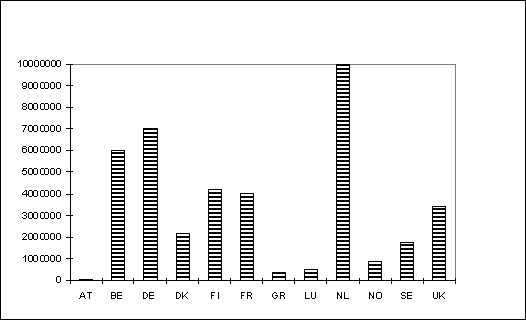
Figure 1 : Total
number of records in each country (calculated for 135 sources)
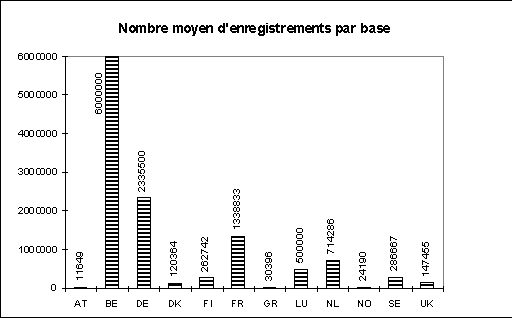
Figure 2 : Mean number of records
in each data source (calculated for 135 sources)
For each source the main objectives of collection
and use of data were specified:
survey of species, habitats or sites, ecological research, genetic information or
policies.
The groups of species, the types of habitats and
sites taken into account by these sources were also specified.
More than 40 % of data sources relate to species.
In figure 3, 42 % of sources relate, among other
objectives, to species, 18 % to sites and 16 % to habitats.
Of 196 sources, 40 % sources concern exclusively
species, 6 % habitats and 4 % sites; the other sources have multiple objectives.
At national level, map n° 1 illustrates a
predominance of data bases relating to species and sites.

Figure 3 : Main topics of
data sources in Europe
Map 1
Main topics of data sources in Europe
Vertebrates: the most studied
species group
More than 50 % of sources on species
deal with Vertebrates among which 22 % are on Birds (figure 4).
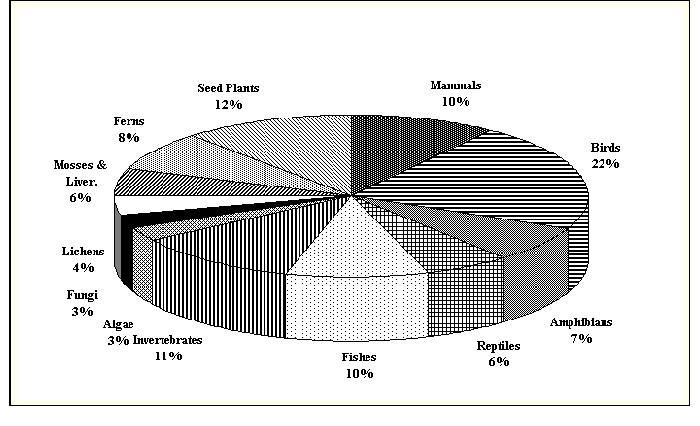
Figure 4 : Species
groups taken into account by data sources in Europe
Data sources on species are very
specialised (even if they are not exclusively related to species) 72 % of these deal only
with one group of which 49 % relate to Birds, 12 % to Invertebrates and 13 % to Mammals.
At national level, data on
Vertebrates are also predominant (map n° 2).
Map 2
Main species groups taken into acccount by data
sources
Few sources on habitats but
all main habitat types are equally taken into account
16 % of sources deal with habitats
(figure 3; page 10) and take into account equally all main types of habitat (figure 5).
Nearly half of the data sources
concern a single type of habitat and this is especially the case for coastal and marine
waters.
Belgium, France and The Netherlands
have no source specialising in habitats (map n°3).
In fact, most of the countries deal
with information on habitats through sources on species and sites and it is often
impossible to use search criteria on habitat type.
However it must be recognised that
the habitat list provided in the questionnaire was too brief to allow a good analysis.
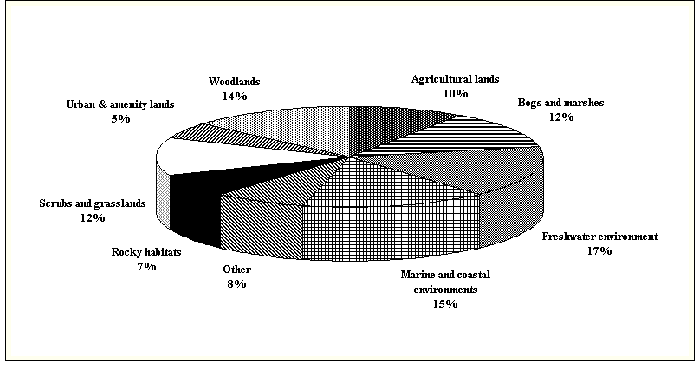
Figure 5 : Habitat types covered
by data sources in Europe
Map 3
A survey of sites : scientific objective
Figure 6 shows that 54 % of data
sources on sites deal with monitoring programmes and scientific inventories.
32 % also hold legal information.
At national level, legal information
exists in 10 countries and scientific inventories in 8 countries (map n° 4).
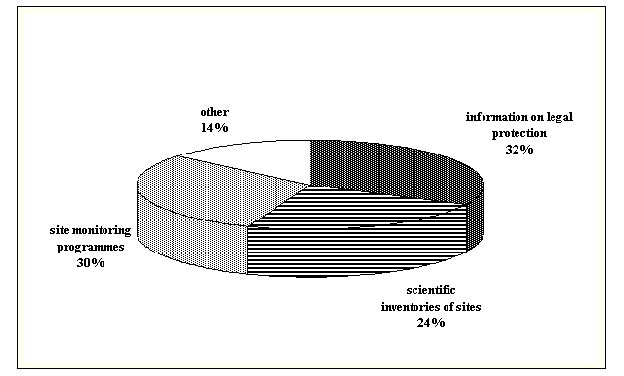
Figure 6 : Site types covered by
data sources in Europe
Map 4
Depending on the objectives of the
sources, parameters used in the sources can be different. Three groups of parameters were
defined in the questionnaire to be more specific about the three main objectives of the
survey : species, habitats or sites.
The most detailed surveys always
relate to Birds.
Nearly 70 % of 150 data sources on
species which include parameter data, contain quantitative data (count data) and more than
50 % concern data on presence/absence (figure 7).
Among these 70 %, 43 sources out of
107 deal exclusively with Birds.
Site management and species data
: the main parameters in sources on habitats
Between 60 and 70 % of sources on
habitats (data calculated on 52 sources relate to this point) collect data on site
management and on species.
Habitat management and quantitative
data (surfaces) are third and fourth most important.
Information on habitats is thus
collected more through survey of species and sites than by survey of habitats.
Types of information on sites
Data on sites concern aspects such
as ownership, management and protection as well as species and habitats.

Figure 7 : Parameters
taken into account by data sources on species, habitats & sites
Data sources are mainly at
national level
Countries were asked to describe
data sources of national importance (fig. 8) but it did not mean that geographical
coverage of data had to be limited to national level.
In fact, 11 % of sources have a
broader coverage than their country. For example, some sources deal with all Scandinavian
countries or with the marine environment. (Datasets held by international organisations or
associations have not been taken into account here) ( map n° 5).
Data sources from local and regional
levels could also be of European and national importance if they describe habitats or
species of community interest.
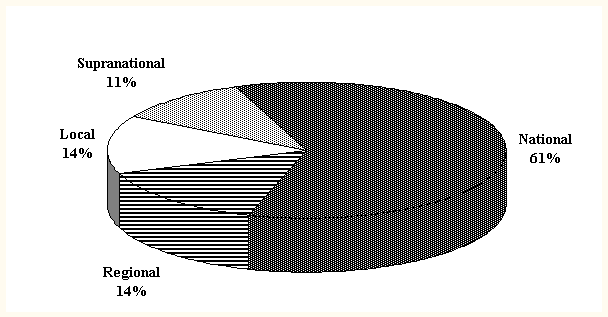
Figure 8 :
Geographical coverage taken in account by data sources in Europe
Map 5
Main dataholders are public
organisations
In Europe, 51 % of data on nature
topics is managed by public institutes, 24 % by governmental organisations and 16 % by
associations.
Excluding the 57 Norwegian data
sources (managed by 4 public organisations and 1 NGO), it becomes 39 % institutes, 26 %
governmental organisations and 22 % associations (fig. 9).
According to map n°6, NGOs are
important dataholders in Greece, Sweden, Netherlands and United-Kingdom.
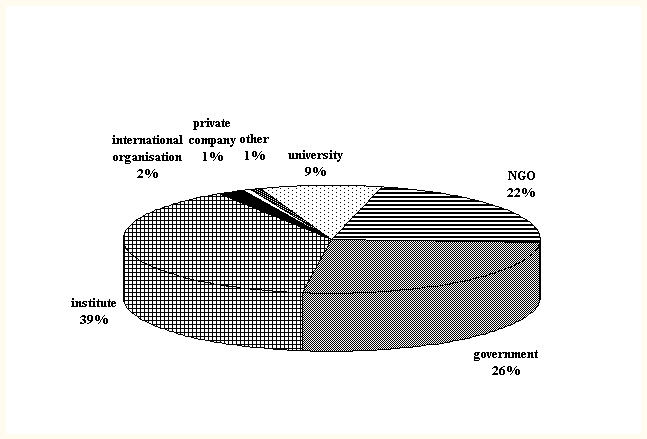
Figure 9 : Main
holders of data sources in Europe
Map 6
Collection of data is made by
official staff, monitoring programmes and volunteers
34 % of data are collected by
official staff*, 20 % by monitoring programmes and 19 % by volunteers (figure 10).
*
official staff: data collected in the frame of staff work out of official
programmes
monitoring programmes: data collected in the frame of official monitoring
programmes
volunteers naturalists: data collected by naturalists or by in-house
staff during their spare-time
literature: extraction of historical & recent records from published
or unpublished sources
museum collections: historical data attached to specimens in a museum
collection

Figure 10 : Sources
of collected data
Map n°7 shows the main tendency at
each national level.
Map 7
With few exceptions, all data
sources are subject to deontological rules
One or more deontological rules
apply to nearly all sources (fig. 11): data collection (27%), access to data (28 %),
diffusion and publication (24 %), pricing criteria (19%).
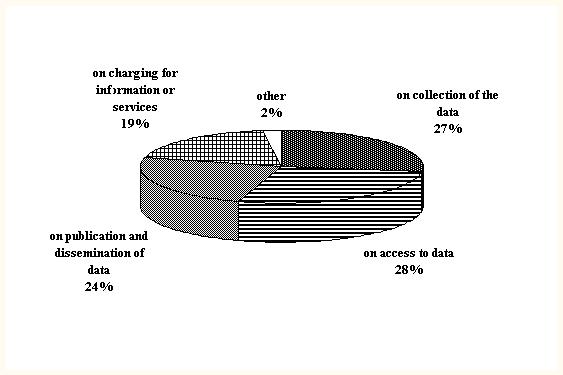
Figure 11 : Deontology
applied to data sources












Document Actions
Share with others